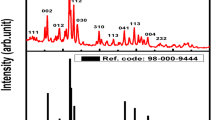Abstract
We have studied the effect of Bi3+ and Ca2+ cation additions and partial Si, P, and V substitutions for Mo on the photoluminescence of NaY1−x Eu x (MoO4)2 scheelite-like red phosphors. The results demonstrate that the photoluminescence intensity in NaY1 − x Eux(MoO4)2 doped with Bi3+ and Ca2+ increases with europium concentration, up to x = 0.5, without concentration quenching. When the atomic fraction of Bi3+ is 0.2, it has a sensitizing effect on Eu3+. Ca2+ doping to an atomic fraction of 0.45 also increases the photoluminescence intensity. Partial Si, P, and V substitutions for Mo have little effect on the photoluminescence intensity.
Similar content being viewed by others
References
Sokolov, V.V. and Uskov, E.M., High-Color-Rendering Bright Red Phosphor Based on NaY1 − x Eux(MoO4)2, Khim. Interesakh Ustoich. Razvit., 2000, vol. 8, nos. 1–2, pp. 281–284.
Liua Jie, Liana Hongzhou, and Shia Chunshan, Improved Optical Photoluminescence by Charge Compensation in the Phosphor System CaMoO4:Eu3+, Opt. Mater., 2007, vol. 29, no. 12, pp. 1591–1594.
Wanga Zhengliang, Liang Hongbin, Gong Menglian, and Sua Qiang, Luminescence Investigation of Eu3+ Activated Double Molybdates Red Phosphors with Scheelite Structure, J. Alloys Compd., 2007, vol. 432, nos. 1–2, pp. 308–312.
Yan Bing and Wua Jian-Hua, NaY(MoO4)2:Eu3+ and NaY0.9Bi0.1(MoO4)2:Eu3+ Submicrometer Phosphors: Hydrothermal Synthesis Assisted by Room Temperature Solid State Reaction, Microstructure and Photoluminescence, Mater. Chem. Phys., 2009, vol. 116, no. 1, pp. 67–71.
Haque Masuqul, Lee Hong-In, and Kim Dong-Kuk, Luminescent Properties of Eu3+-Activated Molybdate-Based Red-Emitting Phosphors for LEDs, J. Alloys Compd., 2009, vol. 481, nos. 1–2, pp. 792–796.
Tsybulya, S.V., Cherepanova, S.V., and Solov’eva, S.P., Polikristall Software Package for IBM/PC, Zh. Strukt. Khim., 1996, vol. 37, no. 2, pp. 379–382.
Chi, L.S., Liu, R.S., and Lee, B.G., Synthesis of Y2O3:Eu,Bi Red Phosphors by Homogeneous Coprecipitation and Their Photoluminescence Behaviors, J. Electrochem. Soc., 2005, vol. 152, no. 8, pp. 93–98.
Strel’tsov, A.V., Dmitrienko, V.P., Akmaeva, T.A., et al., The Influence of Activation of Y2O3 Polycrystalline Matrices by Bi3+ Ions on the Luminescence of Y2O3:Eu3+, Inorg. Mater., 2009, vol. 45, no. 8, pp. 889–893.
Author information
Authors and Affiliations
Corresponding author
Additional information
Original Russian Text © E.S. Zolotova, M.I. Rakhmanova, V.V. Sokolov, E.M. Uskov, 2011, published in Neorganicheskie Materialy, 2011, Vol. 47, No. 11, pp. 1368–1371.
Rights and permissions
About this article
Cite this article
Zolotova, E.S., Rakhmanova, M.I., Sokolov, V.V. et al. Influence of bismuth and calcium on the luminescence intensity of NaY1 − x Eu x (MoO4)2 phosphors. Inorg Mater 47, 1249–1252 (2011). https://doi.org/10.1134/S0020168511100244
Received:
Published:
Issue Date:
DOI: https://doi.org/10.1134/S0020168511100244




